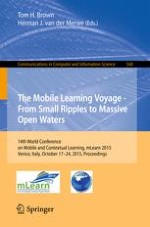This book constitutes the proceedings of the 14th International Conference on Mobile and Contextual Learning, mLearn 2015, held in a cruise ship leaving from and arriving to Venice, Italy, in October 2015.
The 22 revised full papers and 6 short papers presented were carefully reviewed and selected from 81 submissions. The papers deal with the topics related to the theme of the conference: "The mobile learning voyage: from small ripples to massive open waters". The conference theme paid tribute to the developments that brought mobile learning from its infancy steps in the early 2000s to maturity in 2015, while simultaneously paving the way for the broad and open waters ahead with new developments and progress in mobile learning, and emerging ambient technologies.
